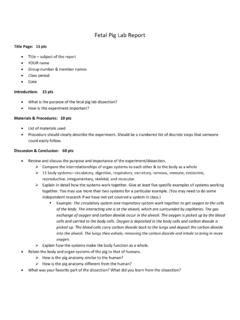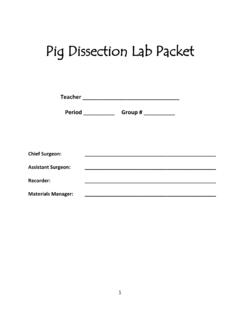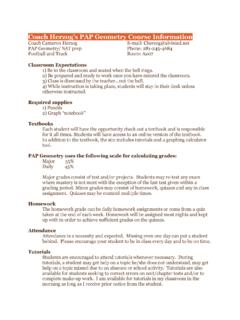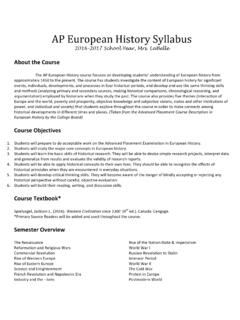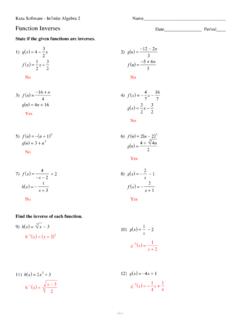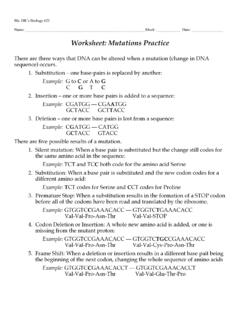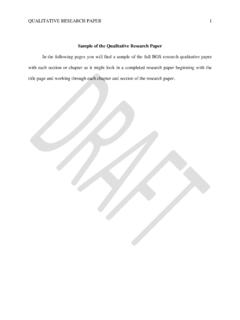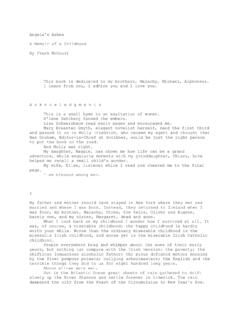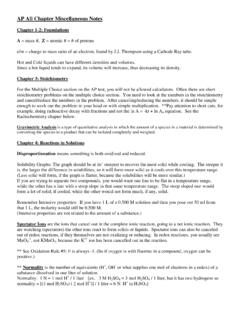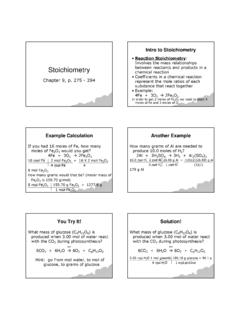Transcription of Practice Test Ch 3 Stoichiometry Name Per
1 Remember, this is Practice - Do NOT cheat yourself of finding out what you are capable of doing. Be sure you follow the testing conditions outlined below. DO NOT USE A CALCULATOR. AP Chem does not allow the use of a calculator for the MC part of the exam, so it is time to start practicing without one. You may use ONLY a periodic table. While you should Practice working as fast as possible, it is more important at this point in the course, that you Practice without a calculator, even if it slows you down. Look for the easy math common factors and rough estimation do not do long division to try to get exact values. Remember it is a MC test, use the answers Mark which questions you would like to go over when we get to school in the following equation:___NH3 + ___O2 ___NO2 + ___H2 OThe balanced equation shows that mole of NH3 requires ___ mole(s) of a balanced equation for the combustion of acetaldehyde, properly balanced, the equation indicates that ___ mole(s) of O2 are required for each mole of is the total mass of products formed when 16 grams of CH4 is burned with excess oxygen?
2 G g g a balanced equation for the combustion of propane, balanced, the equation indicates that ___ moles of O2 are required for each mole of the following equation with the SMALLEST WHOLE NUMBER COEFFICIENTS possible. Select the number that is the sum of the coefficients in the balanced equation:___KClO3 ___KCl + the mass of hydrogen formed when 27 g of aluminum reacts with excess hydrochloric acid according to the balanced equation + 6 HCl 2 AlCl3 + 3 g many grams of nitric acid, HNO3, can be prepared from the reaction of 138 g of NO2 with g H2O according to the equation below?3NO2 + H2O 2 HNO3 + of the following statements is true? molar mass of CaCO3 is g mol g of CaCO3 contains 9 1023 oxygen 200 g sample of CaCO3 contains 2 moles of and III , II, and III Practice Test Ch 3 Stoichiometry Name_____Per_____2 MnO2 + 4 KOH + O2 + Cl2 2 KMnO4 + 2 KCl + 2 the reaction above, there is 100.
3 G of each reactant available. Which reagent is the limiting reagent?[Molar Masses: MnO2 = ; KOH= ; O2 = ; Cl2 = ] all run out at the same reaction of g benzene, C6H6, with excess HNO3 resulted in g of H2O. What is the percentage yield?Molar Mass (g/mol): C6H6=78 HNO3=63 C6H5NO2=123 H2O=18C6H6 + HNO3 C6H5NO2 + many grams of H2O will be formed when g H2 is allowed to react with g O2 according to2 H2 + O2 2 g g of H2 reacts with g of O2 in an explosion, the final gas mixture will , H2O, and and H2O and H2O only and O2 g of metal carbonate, containing an unknown metal, M, were heated to give the metal oxide and g (s) + heat MO(s) + CO2(g)What is the identity of the metal M? given sample of some hydrocarbon is burned completely and it produces g of CO2 and g of H2O.
4 Determine the empirical formula of the simplest formula for a hydrocarbon that is percent hydrogen by mass mass of Al is produced when mole of Al2S3 is completely reduced with excess H2? g a sample of an unknown mineral was dissolved in acid, of CO2 were generated. If the rock contained no carbonate other than MgCO3, what was the percent of MgCO3 by mass in the limestone?Molar mass (g/mol): MgCO3 = 84 and CO2 = of the following represents the correct method for converting g of copper metal to the equivalent number of copper atoms? 10231 1023 10231 1023 Practice Test Ch3 Stoichiometry (page 2 of 2) mass of element X found in mole of each of four different compounds is g, g, g, and 70 g, respectively.
5 The possible atomic weight of X (g) + 2O2(g) N2O4(g) above reaction takes place in a closed flask. The initial amount of N2(g) is 8 mole, and that of O2(g) is 12 mole. There is no N2O4(g) initially present. The experiment is carried out at constant temperature. What is the total amount of mole of all substances in the container when the amount of N2O4(g) reaches 6 mole? mole that there are two naturally occurring isotopes of gallium, 69Ga and 71Ga, the natural abundance of the 71Ga isotope must be % % % % %2Ca3(PO4)2 + 10C + 6 SiO2 P4 + 6 CaSiO3 + phosphorus can be produced by the reduction of phosphate minerals in an electric furnace. What mass of carbon would be required to produce mol of P4 in the presence of 1 mol of calcium phosphate and 3 mol of silicon dioxide?
6 G which of the following compounds is the mass ratio of element X to oxygen closest to to 1? (The molar mass of X is g/mol.) 6H+ + 5H2O2 + 2 MnO4 5O2 + 2Mn2+ + to the balanced equation above, how many moles of the permanganate ion are required to react completely with ml of M hydrogen peroxide? mol molFor the Free Response you may use a calculator and Periodic g sample containing calcium carbonate and an inert material was placed in excess hydrochloric acid. A reaction occurred producing calcium chloride, water, and carbon dioxide.(a)Write a balanced equation for the reaction.(b)When the reaction was complete, g of carbon dioxide gas was collected. How many moles of calcium carbonate were consumed in the reaction?
7 (c)If all the calcium carbonate initially present in the sample was consumed in the reaction, what percent by mass of the sample was due to calcium carbonate?(d)If the inert material was only silicon dioxide, what was the mole fraction of silicon dioxide in the mixture? mole fraction = N1=n1ntotal(e)In fact perhaps there had been some other material present in the original sample that was not so inert and generated a gas during the reaction. Would this have caused the calculated percentage of calcium carbonate in the sample to be higher, lower or have no effect? Justify your Test Ch3 Stoichiometry (page 3 of 3) It might be easiest to balance the equation with mostly whole numbers: 2 NH3 + O2 2NO2 + 3H2O. The question asks about the amount of oxygen reacting with ONE mole of ammonia, thus cut the ( ) of oxygen in half to Balance: CH3 CHO + O2 2CO2 + 2H2O Note: If you are having trouble balancing equations, you MUST act fast on the first day of school and get in for some extra Balance: CH4 + 2O2 CO2 + 2H2O Then do some Stoichiometry using easy math 16 g of methane (MM = 16) is 1 mole and 1 mole of methane will produce 1 mole of CO2 = 44 g, and 2 moles of H2O which is 36 g for a total of 80 Balance: C3H8 + 5O2 3CO2 + Balance.
8 2 KClO3 2 KCl + In multiple choice questions without a calculator, you must look for the easy math You will be most successful at this if you put all the numbers in the dimensional analysis on the page and look for common factors you can cancel out. 27gAl1mol27g 3H22Al 2g1mol = 3 g H2 First you must realize this is a limiting reactant problem. You can tell this since you are given quantities for both reactants. Convert both values to moles: 138gNO21mol46g =3molNO2 and 54gH2O1mol18g =3molH2O Clearly the NO2 limits since the balanced equation tells us that 3 moles are required for every one mole of water, thus use the limiting reactant to determine the amount of acid that can be produced. 3molNO22 HNO33NO2 63g1mol = Add the molar mass of CaCO3 (40 + 12 + 3 16 = 100), thus I is correct.
9 Remember that molar mass is the mass of one mole. The units are often shown as g/mol, but g mol 1 is equivalent since raised to the 1 power means reciprocal, or in the denominator. Since I is true, III is equally true, because 2 moles would weigh twice as much. II is also true because 50 g is mole of the compound, and since there are 3 moles of oxygen atoms per mole of compound, 50gCaCO31molCaCO3100gCaCO3 3molO1molCaCO3 1023atoms1mol =9 The quickest way to determine limiting reactant is to convert to moles and divide each mole value by the coefficient in the balanced equation. Whichever substance turns up as the smallest number will be the limiting reactant. Again remember to use approximations since you would not have access to a calculator to do any of these MC questions.
10 Thus, 2=just> 4=just< thus the KOH limits the 1= ~ 1= ~ Look for easy approximations: = and continue 18g1mol = percent yield also will be easy values: 100=50% Again, this is a limiting reactant problem, 32 g of H2 is 16 moles and is far in excess of the moles of O2 available. Thus the O2 limits the reaction. Set up the dimensional analysis and look for easy 2H2O1O2 18g1mol = First you should recognize that you need to write a balanced equation: 2H2 + O2 2H2O Next, realize that this is a limiting reactant problem 2 g of H2 is 1 mole and 32 g of O2 is 1 mole. The 1 mole of H2 will limit the reaction, thus we know that after the reaction stops, O2 will remain in the container with the H2O Test Ch 3 Stoichiometry This problem requires a bit more clever thought and understanding.
